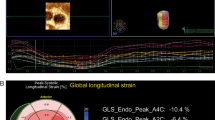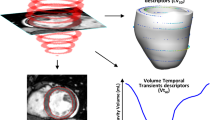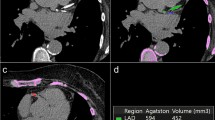Abstract
Objectives
This study aimed to evaluate the feasibility and reproducibility of using cardiovascular magnetic resonance feature tracking (CMR-FT) for analysis of bi-ventricular strain and strain rate (SR) in hypertrophic cardiomyopathy (HCM) patients as well as to explore the correlation between right ventricular (RV) and left ventricular (LV) deformation.
Methods
A total of 60 HCM patients and 48 controls were studied. Global and segmental peak values of bi-ventricular longitudinal, circumferential, radial strain, and systolic SR were analyzed. Pearson analysis was performed to investigate the correlation of RV and LV deformation. Intra-observer and inter-observer reproducibility were also assessed.
Results
LV mass in the HCM group was significantly higher than that in the control group. LV end-systolic and end-diastolic volume and RV end-systolic and end-diastolic volume in the HCM group were all significantly lower than the correlated parameters in the control group (p < 0.001, respectively), whereas no statistical difference was found in ejection fraction (p > 0.05). Global longitudinal strain (GLS), global longitudinal strain rate (GLSR), global circumferential strain (GCS), global circumferential strain rate (GCSR), global radial strain (GRS), and global radial strain rate (GRSR) of the LV and RV were all significantly lower than the control group, and segmental strain and SR were also true (p < 0.001, respectively). Bi-ventricular strain and SR measurements were highly reproducible at both intra- and inter-observer levels. Additionally, Pearson analysis showed RV GCS, GLS, and GRS positively correlated with LV GCS, GLS, and GRS (r = 0.713, p < 0.001; r = 0.728, p < 0.001; r = 0.730, p < 0.001, respectively).
Conclusions
CMR-FT is a promising approach to analyze impairment of global and segmental myocardium deformation in HCM patients non-invasively and quantitatively.
Key Points
• CMR-FT allows for advanced myocardial characterization with high reproducibility.
• As compared with controls, HCM patients have significant differences in CMR-FT strain analysis while ejection fraction was similar.
• CMR-FT may serve as an early biomarker of HCM in subjects at risk.






Similar content being viewed by others
Abbreviations
- CMR-FT:
-
Cardiovascular magnetic resonance feature tracking
- EF:
-
Ejection fraction
- GCS:
-
Global circumferential strain
- GCSR:
-
Global circumferential strain rate
- GLS:
-
Global longitudinal strain
- GLSR:
-
Global longitudinal strain rate
- GRS:
-
Global radial strain
- GRSR:
-
Global radial strain rate
- HCM:
-
Hypertrophic cardiomyopathy
- LV:
-
Left ventricular
- pEF:
-
Preserved ejection fraction
- RV:
-
Right ventricular
- SR:
-
Strain rate
- SSFP:
-
Standard steady-state free precession
References
Mikami Y, Kolman L, Joncas SX et al (2014) Accuracy and reproducibility of semi-automated late gadolinium enhancement quantification techniques in patients with hypertrophic cardiomyopathy. J Cardiovasc Magn Reson 16:85
Amano Y, Kitamura M, Tachi M, Takeda M, Mizuno K, Kumita S (2014) Delayed enhancement magnetic resonance imaging in hypertrophic cardiomyopathy with basal septal hypertrophy and preserved ejection fraction: relationship with ventricular tachyarrhythmia. J Comput Assist Tomogr 38:67–71
Edvardsen T, Helle-Valle T, Smiseth OA (2006) Systolic dysfunction in heart failure with normal ejection fraction: speckle-tracking echocardiography. Prog Cardiovasc Dis 49:207–214
Ozawa K, Funabashi N, Takaoka H et al (2015) Characteristic myocardial strain identified in hypertrophic cardiomyopathy subjects with preserved left ventricular ejection fraction using a novel multi-layer transthoracic echocardiography technique. Int J Cardiol 184:237–243
Vergé MP, Cochet H, Reynaud A et al (2018) Characterization of hypertrophic cardiomyopathy according to global, regional, and multi-layer longitudinal strain analysis, and prediction of sudden cardiac death. Int J Cardiovasc Imaging 34:1091–1098
Schuster A, Morton G, Hussain ST et al (2013) The intra-observer reproducibility of cardiovascular magnetic resonance myocardial feature tracking strain assessment is independent of field strength. Eur J Radiol 82:296–301
Augustine D, Lewandowski AJ, Lazdam M et al (2013) Global and regional left ventricular myocardial deformation measures by magnetic resonance feature tracking in healthy volunteers: comparison with tagging and relevance of gender. J Cardiovasc Magn Reson 15:8
Wu XP, Li YD, Wang YD et al (2019) Impaired right ventricular mechanics at rest and during exercise are associated with exercise capacity in patients with hypertrophic cardiomyopathy. J Am Heart Assoc 8:e011269
Orwat S, Kempny A, Diller GP et al (2014) Cardiac magnetic resonance feature tracking: a novel method to assess myocardial strain. Comparison with echocardiographic speckle tracking in healthy volunteers and in patients with left ventricular hypertrophy. Kardiol Pol 72:363–371
Cameli M, Righini FM, Lisi M et al (2013) Comparison of right versus left ventricular strain analysis as a predictor of outcome in patients withsystolic heart failure referred for heart transplantation. Am J Cardiol 112:1778–1784
Matsumoto K, Tanaka H, Onishi A et al (2015) Bi-ventricular contractile reserve offers an incremental prognostic value for patients with dilated cardiomyopathy. Eur Heart J Cardiovasc Imaging 16:1213–1223
Guendouz S, Rappeneau S, Nahum J et al (2012) Prognostic significance and normal values of 2D strain to assess right ventricularsystolic function in chronic heart failure. Circ J 76:127–136
Palit A, Bhudia SK, Arvanitis TN, Turley GA, Williams MA (2012) Computational modelling of left-ventricular diastolic mechanics: effect of fibre orientation and right-ventricle topology. J Biomech 48:604–612
Tseng WY, Dou J, Reese TG, Wedeen VJ (2006) Imaging myocardial fiber disarray and intramural strain hypokinesis in hypertrophic cardiomyopathy with MRI. J Magn Reson Imaging 23:1–8
Fung MJ, Leung DY, Thomas L (2018) Differential myocardial fiber involvement by strain analysis in patients with aortic stenosis. Heart Lung Circ 27:1357–1367
Schober KE, Savino SI, Yildiz V (2016) Right ventricular involvement in feline hypertrophic cardiomyopathy. J Vet Cardiol 18:297–309
Lee JH, Park JH (2018) Strain analysis of the right ventricle using two-dimensional echocardiography. J Cardiovasc Imaging 26:111–124
Pedrizzetti G, Claus P, Kilner PJ, Nagel E (2016) Principles of cardiovascular magnetic resonance feature tracking and echocardiographic speckle tracking for informed clinical use. J Cardiovasc Magn Reson 18:51
Cincin A, Tigen K, Karaahmet T et al (2015) Right ventricular function in hypertrophic cardiomyopathy: a speckle tracking echocardiography study. Anatol J Cardiol 15:536–541
Driessen MM, Baggen VJ, Freling HG et al (2014) Pressure overloaded right ventricles: a multicenter study on the importance of trabeculae in RV function measured by CMR. Int J Cardiovasc Imaging 30:599–608
Krylova NS, Demkina AE, Poteshkina NG, Khashieva FM (2014) Tissue Doppler imaging and ultrasonic methods for evaluating myocardial deformation in the diagnosis of hypertrophic cardiomyopathy. Kardiologiia 54:79–84
Liu Y, Deng Y, Li X, Chang Q, Lu Y, Li C (2005) Assessment of left ventricular longitudinal regional myocardial systolic function by strain imaging echocardiography in patients with hypertrophic cardiomyopathy. J Huazhong Univ Sci Technol Med Sci 25:703–705
Badran HM, Soliman M, Hassan H, Abdelfatah R, Saadan H, Yacoub M (2013) Right ventricular mechanics in hypertrophic cardiomyopathy using feature tracking. Glob Cardiol Sci Pract 2:185–197
Hinojar R, Fernández-Golfín C, González-Gómez A et al (2017) Prognostic implications of global myocardial mechanics in hypertrophic cardiomyopathy by cardiovascular magnetic resonance feature tracking. Relations to left ventricular hypertrophy and fibrosis. Int J Cardiol 249:467–472
Bogarapu S, Puchalski MD, Everitt MD, Williams RV, Weng HY, Menon SC (2016) Novel cardiac magnetic resonance feature tracking (CMR-FT) analysis for detection of myocardial fibrosis in pediatric hypertrophic cardiomyopathy. Pediatr Cardiol 37:663–673
Wu L, Germans T, Guclu A, Heymans MW, Allaart CP, van Rossum AC (2014) Feature tracking compared with tissue tagging measurements of segmental strain by cardiovascular magnetic resonance. J Cardiovasc Magn Reson 16:10
Andre F, Steen H, Matheis P et al (2015) Age- and gender-related normal left ventricular deformation assessed by cardiovascular magnetic resonance feature tracking. J Cardiovasc Magn Reson 17:25
Shehata ML, Cheng S, Osman NF, Bluemke DA, Lima JAC (2009) Myocardial tissue tagging with cardiovascular magnetic resonance. J Cardiovasc Magn Reson 11:55
Roşca M, Călin A, Beladan CC et al (2015) Right ventricular remodeling, its correlates, and its clinical impact in hypertrophic cardiomyopathy. J Am Soc Echocardiogr 281:1329–1338
Lamacie MM, Thavendiranathan P, Hanneman K et al (2017) Quantification of global myocardial function by cine MRI deformable registration-based analysis: comparison with MR feature tracking and speckle-tracking echocardiography. Eur Radiol 274:1404–1415
D’Andrea A, Limongelli G, Baldini L et al (2017) Exercise speckle-tracking strain imaging demonstrates impaired right ventricular contractile reserve in hypertrophic cardiomyopathy. Int J Cardiol 227:209–216
Schmidt B, Dick A, Treutlein M, Schiller P et al (2017) Intra- and inter-observer reproducibility of global and regional magnetic resonance feature tracking derived strain parameters of the left and right ventricle. Eur J Radiol 89:97–105
Chacko BR, Karur GR, Connelly KA et al (2018) Left ventricular structure and diastolic function by cardiac magnetic resonance imaging in hypertrophic cardiomyopathy. Indian Heart J 70:75–81
Acknowledgments
The authors would like to specially thank Professor Lingzhi Hu, M.D. (from united imaging healthcare), for his expert advices for the design of our experiments and the image analyses. In addition, we thank Assistant Professor YingFeng Tu, Ph.D. (Cardiology Department of the 2nd Harbin Medical University Affiliated Hospital, Harbin, China), and QunShao, Ph.D. (Cardiology Department of the 3rd Harbin Medical University Affiliated Hospital, Harbin, China), for their assistance with the preparation of this manuscript.
Funding
This study has received funding by the National Natural Science Foundation of China General Projects (81571740) (KW), Scientific Research Grant of Heilongjiang Province Natural Science Foundation for Returned Chinese Scholars (LC201436) (KW), Postdoctoral Special Scientific Research Grant of Heilongjiang Provincial Government (LBH-Q17104) (KW), Distinguished Young Scientist Funding of Harbin Medical University Affiliated Tumor Hospital (JCQN2019-02), Key Project of the Climbing Funding of the National Cancer Center (NCC201808B019), Youth Scientific Research Grant of Heilongjiang Province Natural Science Foundation (QC2015127) (LZ), Medical Scientific Research Foundation of Heilongjiang Province Health Department (2014-312) (LZ), and Natural Science Foundation of 2nd Affiliated Hospital Harbin Medical University (KTBS2015-26) (LZ). The funders had no role in study design, data collection and analysis, decision to publish, or preparation of the manuscript.
Author information
Authors and Affiliations
Corresponding authors
Ethics declarations
Guarantor
The scientific guarantor of this publication is Kezheng Wang.
Conflict of interest
The authors of this manuscript declare no relationships with any companies whose products or services may be related to the subject matter of the article.
Statistics and biometry
No complex statistical methods were necessary for this paper.
Informed consent
Written informed consent was obtained from all subjects (patients) in this study.
Ethical approval
Institutional Review Board approval was obtained.
Methodology
• Retrospective
• Observational
• Multicenter study
Additional information
Publisher’s note
Springer Nature remains neutral with regard to jurisdictional claims in published maps and institutional affiliations.
Liping Yang and Lingbo Zhang contributed equally to this work.
Electronic supplementary material
ESM 1
(DOCX 719 kb)
Video S1
LV circumferential strain is displayed in 4D volume. The movie shows a representative case of LV tracking in the short-axis view in HCM patient. (AVI 5501 kb)
Video S2
LV radial strain is displayed in 4D volume. The movie shows a representative case of LV tracking in the short-axis view in HCM patient. (AVI 5497 kb)
Video S3
LV longitudinal strain is displayed in 4D volume. The movie shows a representative case of LV tracking in the long-axis four-ventricular view in HCM patient. (AVI 5728 kb)
Video S4
RV circumferential strain is displayed in 4D volume. The movie shows a representative case of RV tracking in the short-axis view in HCM patient. (AVI 6447 kb)
Video S5
RV longitudinal strain is displayed in 4D volume. The movie shows a representative case of RV tracking in the long-axis four-ventricular view in HCM patient. (AVI 5718 kb)
Video S6
RV radial strain is displayed in 4D volume. The movie shows a representative case of RV tracking in the short-axis view in HCM patient. (AVI 6031 kb)
Rights and permissions
About this article
Cite this article
Yang, L., Zhang, L., Cao, S. et al. Advanced myocardial characterization in hypertrophic cardiomyopathy: feasibility of CMR-based feature tracking strain analysis in a case-control study. Eur Radiol 30, 6118–6128 (2020). https://doi.org/10.1007/s00330-020-06922-6
Received:
Revised:
Accepted:
Published:
Issue Date:
DOI: https://doi.org/10.1007/s00330-020-06922-6




